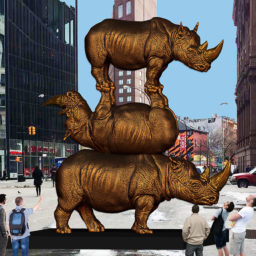

A California man was sentenced to a year in prison for selling a rare black rhinoceros horn to an undercover agent from the U.S. Fish and Wildlife service, according to a report in Courthouse News Service.
Lumsden W. Quan, 46, of San Francisco, and another man, Edward N. Levine, 63, of Mill Valley, California were indicted by a grand jury this past April, according to a news release, for the illegal sale of two horns from an endangered black rhinoceros.
The indictment was a result of a project known as “Operation Crash”—the term used for a herd of rhinos—a nationwide effort led by the U.S. Fish and Wildlife Service and the Justice Department to investigate and prosecute people involved in the black market trade of endangered rhinoceros horns.
According to the indictment, over the course of two months, Quan and Levine negotiated the sale of two black rhino horns “by e-mail and telephone, ultimately communicating with a law enforcement officer acting in an undercover capacity,” according to the Justice Department release. They offered to sell the two horns for $55,000 and agreed to meet the buyer in Las Vegas.
Courthouse News says Quan pleaded guilty, admitting that he worked with Levine to transport the two horns from California to Nevada. Levine is scheduled to stand trial in March.
Quan will spend a year and two days in prison for conspiracy to violate the Lacey and Endangered Species Acts and for violating the Lacey Act with the sale of the rhino horns.
The Justice Department said “Crash” remains ongoing and has so far resulted in 22 convictions and forfeiture and restitution amounts of over $5 million.
The Justice Department says trafficking in rhinoceros horns “has skyrocketed in recent years due to the demand for horn for ornamental carvings, good luck charms or alleged medicinal purposes.” Rhinos have no known predators other than humans. Their populations have declined by more than 90 percent since 1970s. All species of rhinoceros are protected under U.S. and international law.
A lengthy report that appeared earlier this year in National Geographic magazine notes that Levine is a convicted drug dealer who was indicted in Florida in 1989 along with Colombian drug kingpin Pablo Escobar, the Ochoa brothers, and roughly two dozen others on charges linked to their involvement in the Medellin drug cartel.
“The connection between the wildlife trade and illegal drugs is longstanding,” the report says. “U.S. Fish and Wildlife agents have found illegal drugs hidden inside shipments of live wildlife.”
Several years ago, the U.S. Fish and Wildlife service’s restrictions were at the heart of a complicated debate with the estate of legendary dealer Ileana Sonnabend, who had owned Robert Rauschenberg’s seminal “combine” artwork Canyon (1959), since it was initially created and shown at her former husband Leo Castelli’s gallery.
The problem? Twenty years after she acquired it—when shipping it to a museum show—Sonnabend learned that because the work contained a stuffed bald eagle mounted to the canvas, the feathered friend ran afoul of the U.S.’s 1940 Bald and Golden Eagle Protection Act as well as the 1918 Migratory Bird Treaty Act. The law provides criminal penalties for persons who “take, possess, sell, purchase, barter, offer to sell, purchase or barter, transport, export or import, at any time or any manner, any bald eagle . . . alive or dead, or any part, nest, or egg thereof,” according to the U.S. Fish and Wildlife Service website.
In the late 80s Rauschenberg helped Sonnabend out by providing a notarized statement about how he acquired the bird. He recounted that an artist named Sari Dienes lived in the building above Carnegie Hall in New York during the 1950s. Among the other tenants was a member of Teddy Roosevelt’s Rough Riders, the first U.S. Volunteer Cavalry. The man, who was not named, “acquired from the wild, a bald eagle which he had taxidermied prior to 1940,” the statement said. After the man died in 1959, Dienes retrieved the eagle from the trash and offered it to Rauschenberg.The information allowed Sonnabend to retain possession of the eagle, and confirmed that she was the rightful owner. However, the gallery was unable to obtain a special export permit in order to exhibit the work internationally and it can never be sold.
Because it could never be sold, the heirs of the estate and qualified appraisers valued it at zero. But the Internal Revenue Service disagreed and—somewhat inexplicably—valued it at $65 million. After a length tussle with the tax service, the work was eventually donated as a gift to the Museum of Modern Art.








